2009 PONTIAC TORRENT belt
[x] Cancel search: beltPage 390 of 436

Additional Required Services (cont’d)
Service and Miles (Kilometers)25,000
(40 000)50,000
(80 000)75,000
(120 000)100,000
(160 000)125,000
(200 000)150,000
(240 000)
Engine cooling system service (or every
�ve years, whichever occurs �rst).
An Emission Control Service.
See footnote (i).•
Inspect engine accessory drive belt.
An Emission Control Service.
See footnote (m).•
Maintenance Footnotes
(a)Visually inspect brake lines and hoses for proper
hook-up, binding, leaks, cracks, chafing, etc. Inspect
disc brake pads for wear and rotors for surface
condition. Inspect other brake parts, including calipers,
parking brake, etc. Check parking brake adjustment.
(b)Visually inspect front and rear suspension and
steering system for damaged, loose, or missing
parts or signs of wear. Visually check constant velocity
joints, rubber boots, and axle seals for leaks. With
3.4L V6 engine: Inspect electric power steering cables
for proper hook-up, binding, cracks, chafing, etc. With
3.6L V6 engine: Inspect hydraulic power steering lines
and hoses for proper hook-up, binding, leaks, cracks,
chafing, etc.(c)Visually inspect hoses and have them replaced if they
are cracked, swollen, or deteriorated. Inspect all pipes,
fittings and clamps; replace with genuine parts as
needed. To help ensure proper operation, a pressure test
of the cooling system and pressure cap and cleaning the
outside of the radiator and air conditioning condenser is
recommended at least once a year.
(d)Inspect wiper blades for wear, cracking, or
contamination. Clean the windshield and wiper blades,
if contaminated. Replace wiper blades that are worn or
damaged. See Windshield Wiper Blade Replacement
on page 5-47 and Windshield and Wiper Blades on
page 5-87 for more information.
6-8
Page 391 of 436
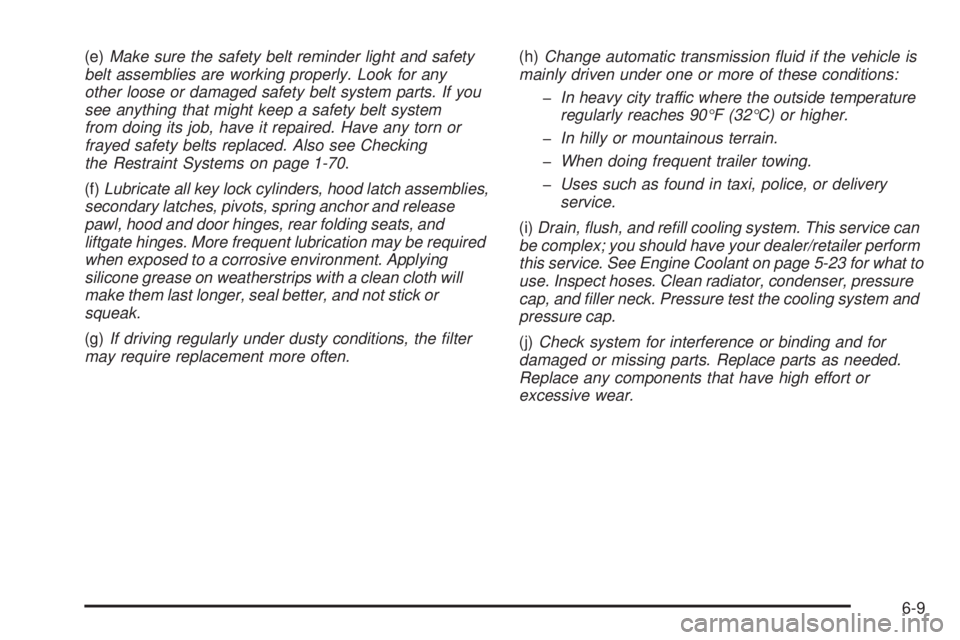
(e)Make sure the safety belt reminder light and safety
belt assemblies are working properly. Look for any
other loose or damaged safety belt system parts. If you
see anything that might keep a safety belt system
from doing its job, have it repaired. Have any torn or
frayed safety belts replaced. Also see Checking
the Restraint Systems on page 1-70.
(f)Lubricate all key lock cylinders, hood latch assemblies,
secondary latches, pivots, spring anchor and release
pawl, hood and door hinges, rear folding seats, and
liftgate hinges. More frequent lubrication may be required
when exposed to a corrosive environment. Applying
silicone grease on weatherstrips with a clean cloth will
make them last longer, seal better, and not stick or
squeak.
(g)If driving regularly under dusty conditions, the filter
may require replacement more often.(h)Change automatic transmission fluid if the vehicle is
mainly driven under one or more of these conditions:
�In heavy city traffic where the outside temperature
regularly reaches 90°F (32°C) or higher.
�In hilly or mountainous terrain.
�When doing frequent trailer towing.
�Uses such as found in taxi, police, or delivery
service.
(i)Drain, flush, and refill cooling system. This service can
be complex; you should have your dealer/retailer perform
this service. See Engine Coolant on page 5-23 for what to
use. Inspect hoses. Clean radiator, condenser, pressure
cap, and filler neck. Pressure test the cooling system and
pressure cap.
(j)Check system for interference or binding and for
damaged or missing parts. Replace parts as needed.
Replace any components that have high effort or
excessive wear.
6-9
Page 392 of 436

(k)A fluid loss in any vehicle system could indicate a
problem. Have the system inspected and repaired
and the fluid level checked. Add fluid if needed.
(l)If driving regularly under dusty conditions, inspect the
filter at each engine oil change.
(m)Visually inspect belt for fraying, excessive cracks, or
obvious damage. Replace belt if necessary.
(n)Severe service is when the vehicle is mainly driven
under one or more of these conditions:
�In heavy city traffic where the outside temperature
regularly reaches 90°F (32°C) or higher.
�In hilly or mountainous terrain.
�When doing frequent trailer towing.
�Uses such as found in taxi, police, or delivery
service.
(o)Change the fluid the first time the vehicle is serviced
after 100,000 miles (166 000 km) and when the
vehicle is serviced after each subsequent 50,000 miles
(83 000 km).Owner Checks and Services
These owner checks and services should be performed
at the intervals speci�ed to help ensure vehicle safety,
dependability, and emission control performance. Your
dealer/retailer can assist with these checks and services.
Be sure any necessary repairs are completed at once.
Whenever any �uids or lubricants are added to the
vehicle, make sure they are the proper ones, as shown
inRecommended Fluids and Lubricants on page 6-13.
At Each Fuel Fill
It is important to perform these underhood checks at
each fuel fill.
Engine Oil Level Check
Notice:It is important to check the engine oil
regularly and keep it at the proper level. Failure to
keep the engine oil at the proper level can cause
damage to the engine not covered by the vehicle
warranty.
Check the engine oil level and add the proper oil if
necessary. SeeEngine Oil on page 5-15.
6-10
Page 398 of 436
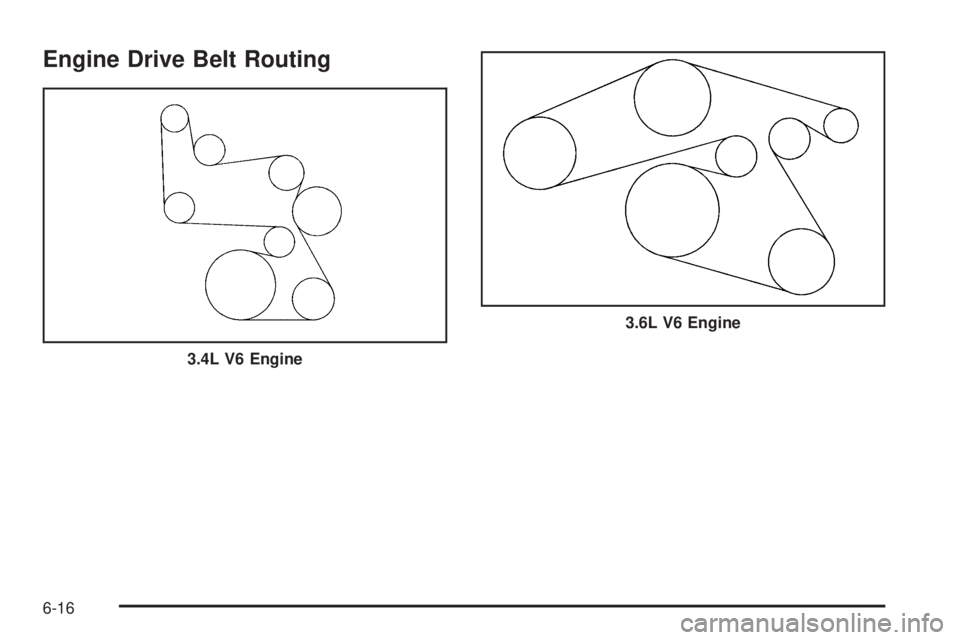
Engine Drive Belt Routing
3.4L V6 Engine
3.6L V6 Engine
6-16
Page 420 of 436
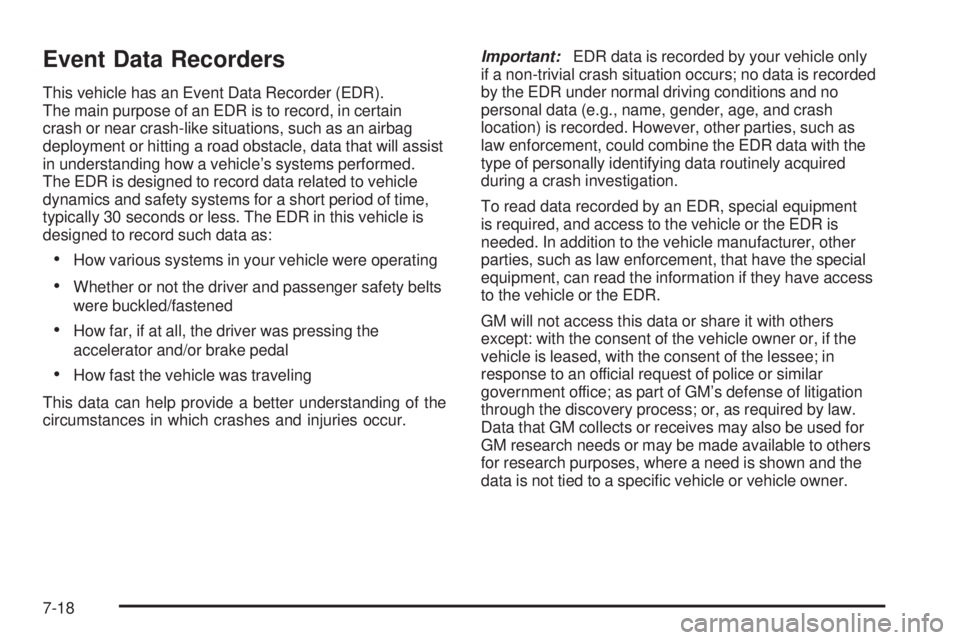
Event Data Recorders
This vehicle has an Event Data Recorder (EDR).
The main purpose of an EDR is to record, in certain
crash or near crash-like situations, such as an airbag
deployment or hitting a road obstacle, data that will assist
in understanding how a vehicle’s systems performed.
The EDR is designed to record data related to vehicle
dynamics and safety systems for a short period of time,
typically 30 seconds or less. The EDR in this vehicle is
designed to record such data as:
How various systems in your vehicle were operating
Whether or not the driver and passenger safety belts
were buckled/fastened
How far, if at all, the driver was pressing the
accelerator and/or brake pedal
How fast the vehicle was traveling
This data can help provide a better understanding of the
circumstances in which crashes and injuries occur.Important:EDR data is recorded by your vehicle only
if a non-trivial crash situation occurs; no data is recorded
by the EDR under normal driving conditions and no
personal data (e.g., name, gender, age, and crash
location) is recorded. However, other parties, such as
law enforcement, could combine the EDR data with the
type of personally identifying data routinely acquired
during a crash investigation.
To read data recorded by an EDR, special equipment
is required, and access to the vehicle or the EDR is
needed. In addition to the vehicle manufacturer, other
parties, such as law enforcement, that have the special
equipment, can read the information if they have access
to the vehicle or the EDR.
GM will not access this data or share it with others
except: with the consent of the vehicle owner or, if the
vehicle is leased, with the consent of the lessee; in
response to an official request of police or similar
government office; as part of GM’s defense of litigation
through the discovery process; or, as required by law.
Data that GM collects or receives may also be used for
GM research needs or may be made available to others
for research purposes, where a need is shown and the
data is not tied to a speci�c vehicle or vehicle owner.
7-18
Page 423 of 436
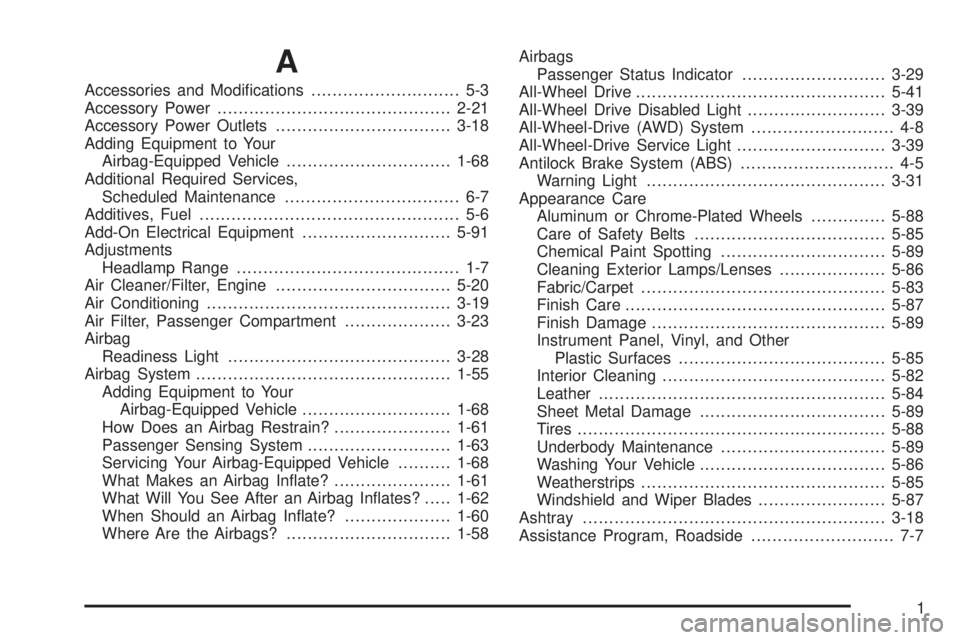
A
Accessories and Modi�cations............................ 5-3
Accessory Power............................................2-21
Accessory Power Outlets.................................3-18
Adding Equipment to Your
Airbag-Equipped Vehicle...............................1-68
Additional Required Services,
Scheduled Maintenance................................. 6-7
Additives, Fuel................................................. 5-6
Add-On Electrical Equipment............................5-91
Adjustments
Headlamp Range.......................................... 1-7
Air Cleaner/Filter, Engine.................................5-20
Air Conditioning..............................................3-19
Air Filter, Passenger Compartment....................3-23
Airbag
Readiness Light..........................................3-28
Airbag System................................................1-55
Adding Equipment to Your
Airbag-Equipped Vehicle............................1-68
How Does an Airbag Restrain?......................1-61
Passenger Sensing System...........................1-63
Servicing Your Airbag-Equipped Vehicle..........1-68
What Makes an Airbag In�ate?......................1-61
What Will You See After an Airbag In�ates?.....1-62
When Should an Airbag In�ate?....................1-60
Where Are the Airbags?...............................1-58Airbags
Passenger Status Indicator...........................3-29
All-Wheel Drive...............................................5-41
All-Wheel Drive Disabled Light..........................3-39
All-Wheel-Drive (AWD) System........................... 4-8
All-Wheel-Drive Service Light............................3-39
Antilock Brake System (ABS)............................. 4-5
Warning Light.............................................3-31
Appearance Care
Aluminum or Chrome-Plated Wheels..............5-88
Care of Safety Belts....................................5-85
Chemical Paint Spotting...............................5-89
Cleaning Exterior Lamps/Lenses....................5-86
Fabric/Carpet..............................................5-83
Finish Care
.................................................5-87
Finish Damage............................................5-89
Instrument Panel, Vinyl, and Other
Plastic Surfaces.......................................5-85
Interior Cleaning..........................................5-82
Leather......................................................5-84
Sheet Metal Damage...................................5-89
Tires..........................................................5-88
Underbody Maintenance...............................5-89
Washing Your Vehicle...................................5-86
Weatherstrips..............................................5-85
Windshield and Wiper Blades........................5-87
Ashtray.........................................................3-18
Assistance Program, Roadside........................... 7-7
1
Page 424 of 436
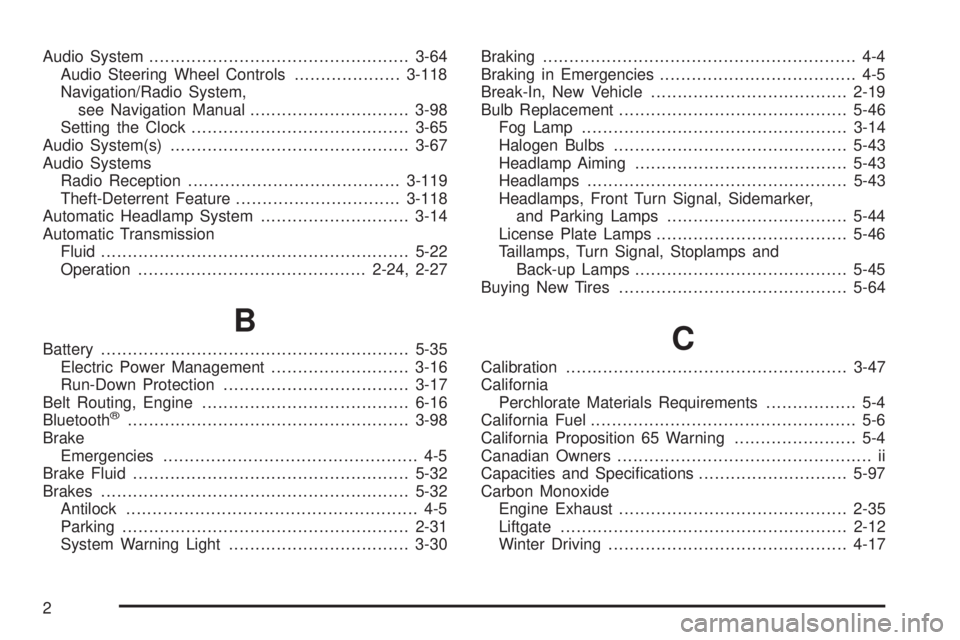
Audio System.................................................3-64
Audio Steering Wheel Controls....................3-118
Navigation/Radio System,
see Navigation Manual..............................3-98
Setting the Clock.........................................3-65
Audio System(s).............................................3-67
Audio Systems
Radio Reception........................................3-119
Theft-Deterrent Feature...............................3-118
Automatic Headlamp System............................3-14
Automatic Transmission
Fluid..........................................................5-22
Operation...........................................2-24, 2-27
B
Battery..........................................................5-35
Electric Power Management..........................3-16
Run-Down Protection...................................3-17
Belt Routing, Engine.......................................6-16
Bluetooth
®.....................................................3-98
Brake
Emergencies................................................ 4-5
Brake Fluid....................................................5-32
Brakes..........................................................5-32
Antilock....................................................... 4-5
Parking......................................................2-31
System Warning Light..................................3-30Braking........................................................... 4-4
Braking in Emergencies..................................... 4-5
Break-In, New Vehicle.....................................2-19
Bulb Replacement...........................................5-46
Fog Lamp ..................................................3-14
Halogen Bulbs............................................5-43
Headlamp Aiming........................................5-43
Headlamps.................................................5-43
Headlamps, Front Turn Signal, Sidemarker,
and Parking Lamps..................................5-44
License Plate Lamps....................................5-46
Taillamps, Turn Signal, Stoplamps and
Back-up Lamps........................................5-45
Buying New Tires...........................................5-64
C
Calibration.....................................................3-47
California
Perchlorate Materials Requirements................. 5-4
California Fuel.................................................. 5-6
California Proposition 65 Warning....................... 5-4
Canadian Owners................................................ ii
Capacities and Speci�cations............................5-97
Carbon Monoxide
Engine Exhaust...........................................2-35
Liftgate......................................................2-12
Winter Driving.............................................4-17
2
Page 425 of 436
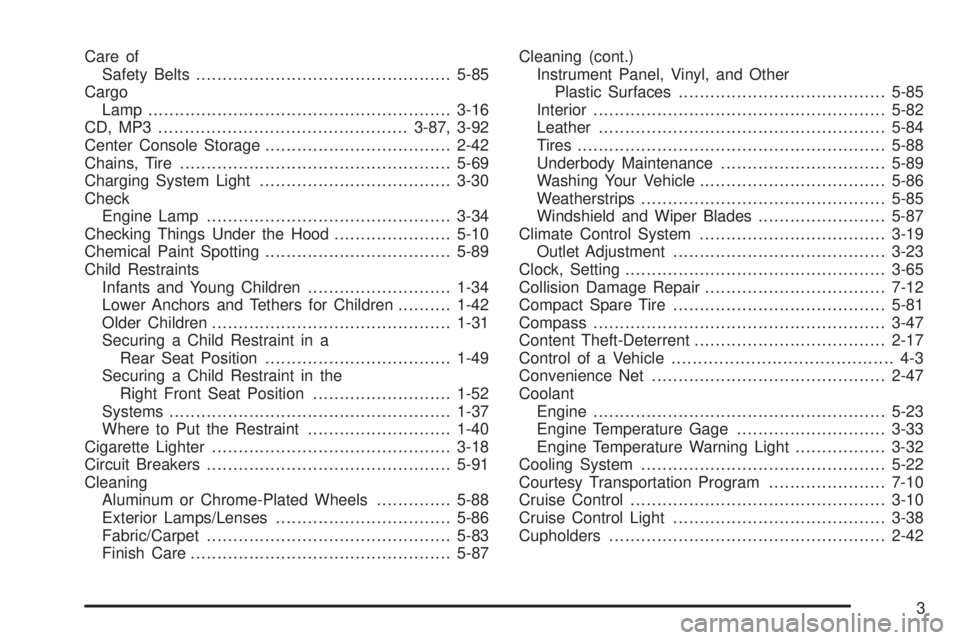
Care of
Safety Belts................................................5-85
Cargo
Lamp .........................................................3-16
CD, MP3 ...............................................3-87, 3-92
Center Console Storage...................................2-42
Chains, Tire...................................................5-69
Charging System Light....................................3-30
Check
Engine Lamp..............................................3-34
Checking Things Under the Hood......................5-10
Chemical Paint Spotting...................................5-89
Child Restraints
Infants and Young Children...........................1-34
Lower Anchors and Tethers for Children..........1-42
Older Children.............................................1-31
Securing a Child Restraint in a
Rear Seat Position...................................1-49
Securing a Child Restraint in the
Right Front Seat Position..........................1-52
Systems.....................................................1-37
Where to Put the Restraint...........................1-40
Cigarette Lighter.............................................3-18
Circuit Breakers..............................................5-91
Cleaning
Aluminum or Chrome-Plated Wheels..............5-88
Exterior Lamps/Lenses.................................5-86
Fabric/Carpet..............................................5-83
Finish Care.................................................5-87Cleaning (cont.)
Instrument Panel, Vinyl, and Other
Plastic Surfaces.......................................5-85
Interior.......................................................5-82
Leather......................................................5-84
Tires..........................................................5-88
Underbody Maintenance...............................5-89
Washing Your Vehicle...................................5-86
Weatherstrips..............................................5-85
Windshield and Wiper Blades........................5-87
Climate Control System...................................3-19
Outlet Adjustment
........................................3-23
Clock, Setting.................................................3-65
Collision Damage Repair..................................7-12
Compact Spare Tire........................................5-81
Compass.......................................................3-47
Content Theft-Deterrent....................................2-17
Control of a Vehicle.......................................... 4-3
Convenience Net............................................2-47
Coolant
Engine.......................................................5-23
Engine Temperature Gage............................3-33
Engine Temperature Warning Light.................3-32
Cooling System..............................................5-22
Courtesy Transportation Program......................7-10
Cruise Control................................................3-10
Cruise Control Light........................................3-38
Cupholders....................................................2-42
3